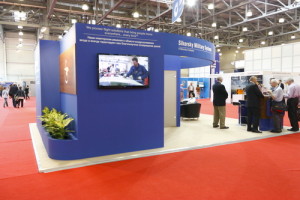
Trade Show Tips – At some stage, all companies will want to exhibit at a trade show. This blog from Goodada will help save you time and effort and help make you money!
Below are 6 Tips that you should consider when preparing to exhibit at a Trade Show:
-
Do as much Pre-Show Promotion as possible.
-
Design and Layout of your stand.
-
Have trained staff working on your stand.
-
Establish your Trade Show Goals and Objectives.
-
How to deal with people who visit your stand.
-
Follow up with the contacts made.
Tip 1 – Do as much Pre-Show Promotion as possible
- Let everybody know that you will be exhibiting at the trade show. You should focus and target all potential customers along with former customers. The objective is to get appointments to meet these people during the show. Please give them a reason to visit the trade show.
- Your trade show promotional materials could mention free passes or special tradeshow offers, which will be available to all those who visit your trade stand.
- Contact any potential customers before the show to try and arrange an appointment time to meet with them during the trade show.
- About two weeks before the show commences, mention your stand number on all emails about the trade show. It may flag any customers to keep an eye out for you when they visit the trade show.
Tip 2 – Design and Layout of your stand
Always remember that there are three types of visitors attending the trade show:
- Visitor Type 1 – Those who know your company and are coming to visit you at the Trade Show
- Visitor Type 2 – Those who know your company but do not know that you are exhibiting at the Show
- Visitor Type 3 – Those who do not know anything about your company or its products
Realistically over 90% of those attending will fall into Type 2 and Type 3. So the objective is to design your stand so that it grabs the attention of these types of visitors as they walk by your trade stand.
On average, a visitor will give your stand 3-5 seconds before they decide whether it is worth stopping at your stand. So design your stand in a way that MAKES THEM STOP!
Your stand should make your company stand out from other exhibitors and explain your company’s unique sales position.
Design your stand with a left to right focus — from the visitor’s perspective. It is how they will scan your stand to determine if they should stop.
- Get your tables out of the way! Make it easy access for visitors to get onto your stand.
- Chairs should only be needed if sit down meetings are required to close a deal. If chairs are required, they should be positioned at the back of the stand.
- Consider using large format images as these are a great option to significantly impact show visitors as they pass by without blowing your budget.
Tip 3 – Have trained staff working on your Stand
It is the staff working at your stand which will make the trade show a success. They are the face of your company and products. The staff will heavily influence the visitor that they interact with. Below are some tips which relate to your exhibition team:
- Have the most positive, approachable and outgoing people staff on your trade stand.
- Hold a pre-show meeting if possible to communicate your strategy, objectives and other opportunities for building relationships at the event.
- Be sure that all your staff are trained to answer all essential questions about your products and organization.
- Make sure that all staff attending the trade show know the targeted trade show goals.
- Ensure that your staff are adequately resourced to achieve their goals and objectives.
Tip 4 – Establish your Trade Show Goals and Objectives
The biggest fault with companies exhibiting is that they do not set down clear goals and objectives. When goals and objectives are clearly defined, everything else falls into place. It would include the layout of the stand, the flyers and information, the targeted visitors, the staff selection, the follow up correspondence with visitors who called to the stand.
Common reasons exhibitors give for participating in shows:
- Introduce new (or modified) products or services.
- Meet new potential clients.
- Make sales.
- Introduce new (or modified) products or services.
- Create an image.
- Increase exposure to a target market.
- Demonstrate a specialized product or service.
- Be compared to your competition.
- Conduct market research.
- Address past servicing problems.
Main Goal
From the list above (or your additional reasons for exhibiting), determine and/ or create a measurable primary goal that achieves your reasons for exhibiting.
- Choose an item that is most important for you to accomplish (X number of solid sales leads for the show).
- Let this primary goal guide you through other decisions on stand design, stand staffing, literature distributed, and other show decisions.
- Trying to achieve too much from one exhibit may lead to disappointment.
- Break this down into smaller goals to give targets to each person staffing your stand to get them in sync with your goals for the show.
Other Objectives
List your backup objectives to ensure you won’t miss any opportunities.
Set Realistic Objectives
If targets are too low, there is no challenge. If they are too high, you end up with frustrated trade show staff.
Tip 5 – How to deal with people who visit your stand
It is essential to spend time finding the correct people to talk to, rather than “pitching” to anybody who walks by the stand.
Suggested Approach
- Be Proactive – Go to the people, don’t wait for people to approach you.
- Find out what they are looking for first, then provide them with information on your products or services to solve what they are looking for solutions on.
- Have specific openers for when people come onto your stand or when you make eye contact with people who pass your stand
- At the start of the trade show, try as many openers as possible so that you can find the one that fits right for the visitors.
- Never say: “Can I help you?” Try: “Have you seen this product?” or “Do you know our company?”
How to Qualify the Prospect Relatively Quickly – A.C.T.I.O.N
Don’t waste your time on useless visitors. You need to assess them very quickly before deciding if they are worth you spending time with them. To do this, you should use the following acronym:
AUTHORITY — Are they decision-makers or have influence?
CASH — Do they have the resources for your products?
TIME — Is this prospect ready to buy within your sales cycle?
IDENTITY — Use a lead card to obtain the required information.
OPERATIONAL CONSTRAINTS — Is there a reason they could not do business with you?
NEED — Does this prospect need your product or service?
Trade Show Presentation
Create a Trade Show Presentation — this is very different from the office demonstration or “pitch.” Be sure your staff can summarize and present the features and benefits of your products or services in less than three minutes. They should be able to use the design of the Trade stand and its layout to help in their pitch.
Keep your staff focused on finding the customer’s need and offering them a solution that solves that need.
Disengage and Move onto the next person
- Once you have finished your job…move on!
- Create a lead sheet to take down the information that you will need to follow up with the visitor. Make it simple for your staff to tick off appropriate boxes for the products or services which interests the visitor. Asking the visitor their info is another excellent way to qualify the visitor. Plus, completing the lead sheet is a great way to disengage the visitor so you can move along to meet other visitors during valuable show hours.
- Use premiums, brochures or contests to help you disengage (Be sure to have effective methods of clearing unqualified visitors quickly.)
- Be polite.
Tip 6 – Follow up with the contacts made
It is the most vital piece to maximize the results from exhibiting at the trade show.
The follow-up methods allow you to create a relationship with prospects and bring back any lost customers. Trade shows allow you the opportunity to have a face-to-face introduction to potential prospects.
Surveys show that less than 20% of exhibitors execute a follow-up plan. Don’t be part of that statistic!
After the show, send an email with information about your company. It will refresh the prospect of your meeting at the show. These actions will dramatically increase your impact on the visitor and get your sales staff to the next key step in your sales process.
Direct Mail
- First mailing 7 – 30 days following the show.
- Send follow up email mail every eight weeks.
- Find interesting and useful things to send to prospects (not expensive); i.e. special announcements or invitations to other shows or events.
Telemarketing
- A telemarketer should have a reason for calling, i.e. set up an appointment or obtain customer needs.
- Telemarketers should be well trained, have product knowledge, understand selling skills, communicate well, and have a pleasant telephone manner.
- All enquiries should be responded to within twenty-four hours.
An effective follow-up program is vital to the success of a show. All of your work and efforts at the show will only be successful if an effective follow-up program is implemented.
About the author
Aidan Conaty MBA, ACMA, GCMA is a business consultant and the founder of Goodada Inspections and the China Trade Consultancy company TCI China.
Contact Person: Aidan Conaty
Mobile- Messenger (Click to Connect)
Laptop / PC (Click to Connect)
Phone:(Europe/ Rest of the World) +353 1 885 3919 ; (UK) +44.020.3287.2990 ; (North America) +1.518.290.6604




